calsfoundation@cals.org
African Americans
African Americans constitute 15.1 percent of Arkansas’s population, according to the 2020 census, and they have been present in the state since the earliest days of European settlement. Originally brought to Arkansas in large numbers as slaves, people of African ancestry drove the state’s plantation economy until long after the Civil War. African Americans have exerted a profound influence upon all aspects of the state’s history and culture.
European Exploration and Settlement through Early Statehood
In August 1721, a party of Frenchmen employed by John Law’s Compagnie d’Occident established a new colony near the banks of the Arkansas River, a few leagues upstream from where it empties into the Mississippi River. Shortly thereafter, French colonial officials conducted a census for their new outpost. Dated February 18, 1723, it showed forty-seven colonists including six Black slaves and an unknown number of children. Black slaves, as well as free Blacks, continued to appear in subsequent censuses for Arkansas carried out during the French and Spanish colonial eras; one of the last such censuses, conducted in 1798, listed 393 colonists including fifty-six slaves.
Following the Louisiana Purchase of 1803, Arkansas became part of the United States, and settlement quickened. By 1820, Arkansas’s population had risen to 14,255, including 1,617 slaves and fifty-nine free Blacks. As a percentage of the total population, however, the Black population had declined slightly from the earlier colonial period, to twelve percent of the total. One explanation for the lack of increase in the Black population was the hesitancy of slave owners to move to Arkansas until its future status as a slaveholding area was resolved. Once the Missouri Compromise of 1820 made it clear, however, that Arkansas’s fate was linked to that of the slaveholding South, both the general population and the Black population of Arkansas grew quickly. Arkansas had enough inhabitants to qualify for statehood by 1836, and, by 1860, the population of Arkansas had leapt to 435,450, of whom 111,115 were slaves and 144 were free Blacks.
Although slavery had become firmly established in Arkansas, the institution was not evenly distributed within the state. Slaveholding and cotton plantations were especially concentrated in the fertile river bottom lands of eastern Arkansas’s Mississippi River Delta and in southern Arkansas’s Gulf Coastal Plain, which together held seventy-four percent of the state’s slave population by 1860. In 1860, 12,131 slaves (eleven percent) belonged to white families owning from one to four slaves, while about 48,000 (forty-three percent) belonged to owners who held from five to twenty-four slaves. For slaves who resided on small or medium-sized farms, the work regimens and material circumstances may not have differed radically from those of their white owners. Very different were the lives of the over 51,000 slaves (forty-six percent) working on the large estates owned by the nine percent of Arkansas slaveholders who possessed from twenty-five to over 500 slaves. Here, slaves generally had less direct contact with their white owners, and the disparity in living conditions was much greater.
While slaves working on large plantations had less opportunity to develop individual ties with their masters, they also had more autonomy. It was on these larger units that true slave communities began to develop and flourish, including African tribal-influenced religious services, traditional folk medicine, and West African folk stories involving animals such as the famous “Brer Rabbit.” The plantation slave communities functioned as extended families. There was no such thing as legal marriages for slaves, and the immediate family could be shattered at any moment by slave sales or estate distributions. Under such circumstances, the personal ties that could develop within the slave communities and the system of mutual practical and emotional support that the slave communities could offer were invaluable.
Although most Arkansas slaves lived in rural areas on farms or plantations, there were also within the state urban slaves. Their number was always small, however, given Arkansas’s overwhelming rural character. Even by the eve of the Civil War, only four percent of the state population (15,502 of 435,450) resided in towns and cities; Little Rock (Pulaski County), the state capital and Arkansas’s largest urban center, had a grand total population of 3,727. Of the 111,115 Arkansas slaves in 1860, only 3,799 were situated in urban locales. Most of the urban slaves were used not so much as revenue producers but simply as help: as cooks, maids, nurses, houseboys, gardeners, stable boys, and coachmen.
Although present from colonial times onward, the number of free Black persons in Arkansas before the Civil War was always small, reaching a maximum of 608 in 1850; two-thirds of these individuals were “mulattoes,” strongly suggesting blood ties to the whites who manumitted them. Unlike the situation in some Southern states, most free Blacks in Arkansas resided in rural areas, most notably Marion County. Clearly an anomaly in a slaveholding society, the free Blacks were viewed with suspicion and distrust by the white majority, as the example they set through their very existence introduced a subversive element into the established social order. Although they were permitted to own real estate, they could not vote or testify against white people in the courts; while not prohibited by statute from owning slaves themselves, public opinion frowned upon the practice, and only a handful ever did.
Fear of possible slave insurrections intensified during the 1820s and 1830s because of the rise of Northern abolitionism and because of the Denmark Vesey conspiracy uncovered in Charleston, South Carolina, in 1822, as well as the famous Nat Turner Rebellion that occurred in Southampton County, Virginia, in 1831. In response, as early as 1825, Arkansas instituted a system of slave patrols to prevent slaves from wandering from their plantations without a pass, and the same impulse that lay behind this measure also led the General Assembly to adopt a law in 1842 prohibiting the immigration of any additional free Blacks into the state after March 1, 1843. Mounting sectional tensions during the 1850s led finally to enactment of a measure in 1859 expelling all free Blacks over the age of twenty-one from Arkansas; any remaining after January 1, 1860, would be subject to enslavement. Even so, the Federal Census of 1860, taken several months after the new law became operative, disclosed that 144 free Blacks still lived in Arkansas. Perhaps conceding the law’s harshness, in 1861, the General Assembly adopted a measure suspending its further operation until January 1, 1863. As events would have it, this was the very day on which another measure would take effect—President Abraham Lincoln’s Emancipation Proclamation.
Civil War through Reconstruction
Throughout the American Civil War, thousands of slaves escaped from bondage in Arkansas and made their way to the Union army encampments. The exact number has never been determined, but anecdotal reports indicate that hundreds, perhaps thousands, died from malnutrition and disease in fetid, unsanitary, hastily constructed “shanty towns” and settlements.
The escaped slaves in their midst created a dilemma and a headache for the Union commanders. One obvious and at least partial solution was to enlist able-bodied adult males into the military itself. In April 1863, Brigadier General Lorenzo Thomas, adjutant general of the U.S. Army, issued an appeal to the freedmen to volunteer for service, and many quickly flocked to the colors. The army immediately recruited three Black companies in Helena (Phillips County), and they became the nucleus for the First Arkansas Volunteer Infantry Regiment (African Descent) Its new commander was Captain Lindley Miller, an abolitionist from a New York regiment. Eventually, over 5,000 former slaves in Arkansas joined the Union army.
White Confederates were incensed at the sight of Black soldiers wearing blue uniforms. Even the notion of Black men fighting for the Confederacy and donning the gray aroused intense ire. Throughout the Confederate States of America (CSA), slaves were sometimes used to help construct earthworks or other military fortifications and were used as cooks, servants to Confederate officers, or in similar capacities, but they were not permitted to enlist. Arkansas’s most brilliant Confederate commander, Major General Patrick Cleburne, learned to his own detriment how great was the opposition to the idea of slaves bearing arms, even if for the Rebel cause. In the winter of 1863–64, facing the Union’s overwhelming numerical superiority and the growing possibility of the Confederacy’s defeat, Cleburne recommended that slaves be recruited into the army and given their freedom in return. Historian Thomas A. DeBlack noted that Cleburne’s proposal, though quietly rejected, damaged his career. The CSA did adopt a similar policy in 1865, but by then it was too late.
The revulsion against the idea of slaves or former slaves bearing arms also affected Rebel attitudes and actions toward Black soldiers serving in the Union army. Lieutenant General Edmund Kirby Smith, the Confederate commander in the Trans-Mississippi West, encouraged those serving under him to treat “armed negroes and their officers” not as regular soldiers protected by ordinary rules of civilized warfare but as runaways and armed insurrectionists. Smith’s policy led directly to the slaughter of captured Black Union soldiers at the Engagement at Poison Spring in south Arkansas on April 18, 1864. Southern white savagery bred more savagery. Soon after, at the Engagement at Jenkins’ Ferry, fought on April 30, 1864, soldiers of the Second Kansas Colored Infantry, the companion unit to the First Kansas Colored Infantry regiment whose survivors had been massacred at Poison Spring, executed a new command of their white officers to “take no prisoners as long as the Rebels…murder our men.”
When the guns of war finally fell silent in Arkansas in May 1865, the circumstances of Black Arkansans had already undergone radical transformation. Slavery had not only collapsed as a practical matter but had been legally abolished in the constitution of a new Unionist state government established in Little Rock during the spring of the previous year. In some respects, however, the new constitution, largely the creation of white Unionists from the Ozark Mountain country of northwest Arkansas, left Black Arkansans in a kind of legal limbo: they were no longer bondsmen, but they were not yet fully free men and women enjoying all the rights of American citizens. While the Unionist state constitution of 1864 eliminated slavery and repudiated secession, for instance, it did not extend the right to vote or hold public office to any Black citizens, not even to those who were literate, owned property, or were soldiers in or veterans of the Union army. One provision in the constitution was reminiscent of the antebellum statutes against free Blacks; it specified that no Blacks not already living in Arkansas could establish residence in the state, except by authority of the government of the United States or under proclamation of the president of the United States.
Conditions worsened further insofar as Black equality was concerned when ex-Confederates gained control of the Arkansas General Assembly following the August 1866 state elections. The new “rebel” legislature of 1866–1867 adamantly refused to ratify the proposed Fourteenth Amendment to the U.S. Constitution. Moreover, the legislature proceeded to adopt a new “Black Code” that contravened the notion of equal protection. Although the code did extend to the freedmen some rights that they had never enjoyed as slaves—including the right to form legal marriages, to enter into legal contracts, to hold property, to sue and be sued, and to give evidence in court—it also imposed upon them special proscriptions: Blacks could not vote or hold public office, serve on juries or in the militia, or attend schools with or intermarry with whites.
Similar actions occurred in other Southern states as well, and eventually these provocations brought about a Northern backlash. Between March and July 1867, Congress passed three new Reconstruction Acts. These new measures set into motion a process whereby the Southern state governments were dismantled and replaced by new, more radical state governments in which Black men could vote, hold public office, and enjoy full political equality.
Former Arkansas slaves immediately seized these new opportunities. Most of the adult Black males who were eligible participated in a new registration of voters conducted by the U.S. Army. Since many ex-Confederates boycotted the registration in protest against the Reconstruction Acts, at its conclusion, Black men constituted thirty-five percent of the state’s new electorate, even though they made up twenty-five percent of the state’s population. Eight Black men served as delegates to the new state constitutional convention of 1868 and actively participated in its deliberations. Under the new Reconstruction state government established by the 1868 constitution, Black men exercised significant political power. Two Black men held cabinet-level state positions. Joseph C. Corbin, a graduate of Oberlin College in Ohio and founder of what is now the University of Arkansas at Pine Bluff (UAPB), served as superintendent of public instruction from 1873 to 1874, while William H. Grey, a native of Washington DC, held the post of commissioner of immigration and state lands from 1872 to 1874. At the height of Reconstruction in 1873, twenty Black men were serving in the Arkansas General Assembly, and numerous Black county and local officials served in the Black-majority counties of the east Arkansas Delta.
Black officeholders used their influence to advance the interests of their people. Those who served in the constitutional convention of 1868 were able to enshrine in that document provisions guaranteeing Black voting and office-holding and creating a system of public schools; they also succeeded in blocking provisions prohibiting interracial marriages. Subsequently, African Americans serving in the General Assembly helped obtain ratification of the Fourteenth Amendment. Further, they also worked successfully for two new state civil rights statutes in 1868 and 1873. The 1873 measure required owners or proprietors of businesses providing public accommodations, including those involving transportation and entertainment, to provide services to all without unequal treatment. Failure to comply could result in stiff fines and possible imprisonment. Another section of the act required that school districts furnish Black children facilities equal to those given white children. The civil rights laws were infrequently enforced, but their presence slowed the development of segregationist practices.
Post Reconstruction through the Gilded Age
These gains continued after Reconstruction ended in Arkansas in 1874. The various rival political alignments that emerged in Arkansas between 1872 and 1874 may have been bizarre, but Arkansas at least managed to avoid the intense racial and political polarization that characterized the collapse of Reconstruction in many other Southern states.
When white conservatives convened a new state constitutional convention on July 14, 1874, to bring Reconstruction in Arkansas to an end, eight Black delegates attended, and the final document included provisions that allowed for the continuance of Black suffrage, Black office-holding, and the new Black school system. In addition, the document even contained a “Declaration of Rights” that was reminiscent of the “equal protection” clause of the U.S. Constitution’s Fourteenth Amendment.
The first governor elected under the new constitution in 1874, white Democrat and “Redeemer” conservative Augustus H. Garland, promised during his gubernatorial campaign that, if elected, he would retain the Civil Rights Act of 1873 and protect Black citizens’ access to the ballot and to free public schools. In his first proclamation as governor, he struck a conciliatory note, asking the different races to unify for the continuing greatness of the state. Garland even encouraged white Democrats in the predominantly African American counties of the Delta to share offices with African Americans through an arrangement known as the “fusion principle.” By this device, political party county committees met before the day of voting and allotted each other places on the ballot. Each party agreed not to contest those positions assigned to the other, and a “compromise ticket” would then be presented at the forthcoming election. Thanks to the operation of this system, Black men continued to vote and hold many local county offices and seats in the state legislature until the early 1890s.
This measure of political equality helped some Black men to realize a degree of economic and social mobility. This was particularly true in the state’s rapidly developing cities and towns, especially in Little Rock, where the population increased from 3,727 in 1860 to 38,307 in 1900. During this same time span, the city’s Black population increased from twenty-three to thirty-eight percent of the city’s total. Most of Little Rock’s Black populace, refugees from the plantations, had limited education and few advanced skills. Toiling as day laborers, porters, and domestic servants, they earned bare subsistence incomes. Even so, a number of factors in Little Rock’s urban milieu opened avenues for potential advancement. These included a more cosmopolitan population possessing at least a modicum of “urbanity” and tolerance for difference; a vigorous multi-party system in which Republicans, Democrats, and members of third parties vied for African Americans’ votes; a well-financed public school system that offered a full nine-month school term, a high school program, and a more diverse curriculum for children of both races; and a white business establishment that prized enterprise, initiative, bustle, and ability, particularly the ability to raise capital and make money, and that was willing to accord a degree of recognition to individual African Americans who demonstrated these qualities.
Thanks to these various factors, urbanization facilitated the appearance of something entirely new in the history of Arkansas race relations: an authentic Black bourgeoisie. By the turn of the century, a thriving Black commercial district had emerged along Little Rock’s West Ninth Street, where a small class of independent Black artisans, craftsmen, and merchants operated their places of business. Similar districts emerged in several other large towns scattered across the state. Above the tradesmen and the shop owners, at the head of Black society, were thriving entrepreneurs and professional men, some of whom had acquired substantial wealth. One notable example was businessman Wiley Jones of Pine Bluff. By the early 1890s, he owned the city’s racetrack, one of its two streetcar systems, extensive rental properties, and was a partner with several prominent whites in one of Pine Bluff’s major real estate development companies; his net worth at that time was estimated to be approximately $300,000.
Education and religion were two spheres, greatly intertwined, in which Black Arkansans were rapidly developing their own institutions. The first state-supported Black institution of higher education in the state was Branch Normal College in Pine Bluff (Jefferson County), now UAPB, which was established in 1873 and opened in 1875. Following it, Black religious groups created three other colleges in the following few years: Philander Smith University, established as Walden Seminary in Little Rock in 1877 for the training of Black Methodist ministers; Arkansas Baptist College, founded as Minister’s Institute by the Colored Baptists of the State of Arkansas in 1884, also in Little Rock; and Shorter College, originally Bethel University, established in Little Rock in 1886 by the African Methodist Episcopal Church but later moved to North Little Rock (Pulaski County). Within the Methodist and Baptist circles, African Americans often organized their own denominations separate from whites, and a few ministers in Arkansas rose to positions of prominence within their respective groups. Elias Camp Morris of Helena, for instance, was elected president of the National Baptist Convention in 1895.
During the same decades in which the lot of some Black urbanites was improving, that of many rural whites was deteriorating. White farmers became restless not only because of the erosion of traditional caste lines that they encountered when visiting the cities and towns, but also because they were increasingly caught up in the same economic mechanisms (e.g., the crop lien, verbal contracts between sharecroppers and landlords, and the convict lease system) used to subjugate rural Blacks. By 1900, of 178,694 farms in Arkansas, 81,140 (45.4 percent) were operated by landless tenants or “croppers” (among Black farmers only, the percentage was seventy-five percent). Of the total number of tenants and sharecroppers in 1900, 34,997 (forty-three percent) were Black, and 46,178 (fifty-seven percent) were white. With the bottom falling out of the cotton market, significant numbers of whites were being placed in economic circumstances that resembled closely those of the most exploited class of Blacks.
By the late 1880s and the early 1890s, large numbers of angry white farmers threatened to “kick over the traces,” leave the Democratic Party, and bolt toward new independent agrarian third parties, such as the Union Labor and Populist organizations. Alarmed Democratic Party elites attempted to prevent defections and distract attention from the troublesome economic and class issues that were beginning to divide the white vote by stoking the flames of racial division.
One way of implementing this strategy was to call for enactment of new “Jim Crow” laws mandating segregation of the races. Responding to a resolution adopted during the preceding year by the Arkansas Democratic state convention, in 1891, the General Assembly passed a new measure requiring separate passenger coaches for the races on railway trains and separate waiting rooms in railway train stations. Though the device of segregated coaches and waiting rooms was new, its intent was to preserve the old caste lines. Arkansas’s urban middle-class Black leadership organized a vigorous though unsuccessful effort to defeat it. Of the twelve Black lawmakers then serving in the General Assembly, all but one voted to reject the separate-coach bill.
At the same time the separate-coach law was enacted, the legislature also centralized Arkansas’s voting system, appointing voting officials in Democratic-controlled state and county boards and impeding illiterates from voting, while also passing a bill proposing a new state constitutional amendment that would require a yearly one-dollar poll tax. Together, these two disfranchisement devices virtually revolutionized Arkansas politics and effectively eliminated the political and civil rights gains won by African Americans during the earlier Reconstruction era. Overall, 65,000 fewer people voted in 1894 than in 1890, an almost one-third drop in elector participation. Republican and third-party candidates naturally suffered most from this decline, particularly so in the state’s six most predominately Black counties where African Americans constituted approximately seventy-five percent or more of the inhabitants. In these areas, the combined opposition lost almost eight times as many votes as the Democrats, enabling the latter to regain complete ascendance. Throughout the eastern Arkansas Delta, Black politicians were swept from local and county offices; moreover, following the session of 1893 until 1973, not a single Black lawmaker served in either house of the Arkansas legislature.
Early Twentieth Century
As the twentieth century dawned, Black Arkansans had little choice but to attempt to achieve group advancement through economic initiatives and pursuit of education (especially the vocational and industrial training programs increasingly demanded by whites) rather than through electoral politics. Some special successes were achieved. The Mosaic Templars of America (MTA), a Black insurance and fraternal organization founded in Little Rock in 1882, grew by the 1920s to become one of the largest Black business enterprises in the United States. However, in an increasingly segregated world, Black entrepreneurs found themselves more than ever shut out of the larger commercial sphere and denied access to the capital needed to finance expansion and growth.
Forced removal of Black politicians from normal political life further constricted opportunities for advancement and success by adversely affecting schooling. As late as the early 1890s, the State of Arkansas was still appropriating roughly the same amount of money per year per Black school child as per white school child. Once disfranchisement was in place, funding for the segregated Black schools began to dwindle. By 1930, Arkansas was spending more than twice as much per year to educate a white child as a Black child in its public school system.
Incidents of lynching, an extra-legal form of group violence, were prevalent in this era; one scholar estimated that, during its peak in the state (roughly the 1860s to the 1930s), at least 318 documented lynchings occurred, 231 victims of which were Black. Perhaps Arkansas’s most notorious lynching is that of John Carter. In April 1927, Little Rock witnessed mob violence against African Americans following the murder of a twelve-year-old white girl. The alleged murderer was taken out of the city to avoid the growing mob of angry whites in the capital. Then, on May 4, 1927, thirty-seven-year-old Black Little Rock resident John Carter was accused of assaulting a local white woman and her daughter. Enraged whites scoured the area in search of Carter. He was found late in the day, hanged from a telephone pole, and shot. Later, his body was set ablaze and dragged through the streets of Little Rock to the corner of Ninth and Broadway—the heart of the city’s Black community.
African Americans were subject to other forms of collective violence as well. Following Reconstruction, some communities broke out into full-fledged “race riots,” in which white mobs committed acts of violence against groups of African Americans, especially those believed to be seeking political, legal, or economic parity with whites. Throughout the late nineteenth century and early twentieth century, African Americans were also subject to “night riding” or “whitecapping,” acts of vigilantism carried out by masked men for the purposes of driving Black workers off land or out of industries. Some communities even expelled all or most of their Black population to become all-white towns known as “sundown towns.”
Notwithstanding the above, it is noteworthy that even during this era, often referred to as the nadir in the history of modern American race relations, the earlier traditions of Black activism and political protest did not entirely disappear. For instance, in 1903, when a bill was introduced in the legislature requiring racial segregation on urban streetcar systems, Black citizens in Little Rock held a mass protest meeting. When the measure became law anyway, mass boycotts of the newly segregated streetcars were organized in Little Rock, Hot Springs (Garland County), and Pine Bluff. Initially, Black traffic on the streetcar lines dropped by over ninety percent in Little Rock, and it appears to have fallen precipitously in Pine Bluff and Hot Springs as well; in all three cities, the boycott continued for weeks. Similarly, when in 1905 a measure was proposed to “segregate” state school taxes so that only revenues collected from Black taxpayers could be used to finance Black education, African Americans spoke out in opposition. John E. Bush, a co-founder of the MTA, formed an unusual coalition with eastern Arkansas planters who feared possible discontent among their plantation labor force if the bill should pass. It was stopped in its tracks, but had it been adopted, it could have destroyed educational opportunities for Arkansas’s Black children.
Another MTA leader, Scipio A. Jones, fought bravely against racial oppression. In 1919, a bloody upwelling of violence against Black citizens occurred near the town of Elaine (Phillips County) after local Black tenants and sharecroppers attempted to unionize. In the end, twelve black men were sentenced to death in show trials for what is now called the Elaine Massacre. Despite the personal risk involved, Jones defended the men and won their freedom.
The persistence of Black activism and protest also fostered continuing involvement in electoral politics. In 1928, Dr. John Marshall Robinson, a Black physician in Little Rock, founded the Arkansas Negro Democratic Association to combat the 1906 “white primary” rule that barred Black voters from participating in the state’s Democratic primaries, which had become the state’s only meaningful elections. Not until 1944 did the U.S. Supreme Court, in the case Smith v. Allwright, declare “white primaries” unconstitutional.
World War II through the Faubus Era
A true “Second Reconstruction,” however, did not appear until the end of World War II. During the war, many Black newspapers carried the “double V” on their mastheads, and their readers understood what this meant: victory abroad and victory at home. Thousands of Black service men and women saw the world, broadening their horizons and increasing their aspirations. Arkansas’s original Tuskegee Airmen were a part of a segregated group composed of African American Army Air Corps cadets, personnel, and support staff known as the Tuskegee Airmen. There were twelve Arkansans documented who performed and maintained various roles at the Tuskegee Institute in Alabama. Approximately 992 pilots were trained at Tuskegee, 450 of whom saw action overseas during the war; four of those were Arkansans.
During and after the war, revelations of the Nazi Holocaust brought racism into increasing disrepute. Energized by these developments, the National Association for the Advancement of Colored People (NAACP) launched a series of court challenges against Jim Crow. Its efforts reached a dramatic culmination in 1954 when the U.S. Supreme Court, in Brown v. Board of Education of Topeka, Kansas, abandoned its previously enunciated “separate but equal” doctrine, declaring racially segregated public schools to be in violation of the “equal protection” clause of the Fourteenth Amendment.
Initial reaction to the Brown decision within Arkansas was surprisingly mild. Governor Francis Cherry remarked that Arkansans had always obeyed the law and would continue to do so, and in the fall of 1954, school districts in the towns of Charleston (Franklin County) and Fayetteville (Washington County) quietly integrated their school classrooms. The following year, however, segregationist groups such as the White Citizens’ Council launched a program of “massive resistance” against implementation of the Brown decision. When the Hoxie (Lawrence County) school board admitted twenty-one Black students to its white schools, white supremacists protested and carried out a campaign of fear and intimidation. School board members eventually were required to obtain a federal court restraining order to ensure that school integration could proceed. In the 1956 election, a majority of Arkansas voters approved a proposed “interposition” amendment and a pupil assignment measure, both directed against integration. Also, the Arkansas General Assembly in early 1957 proceeded to enact four new segregation laws.
Several months transpired, however, before the first great battle of the modern civil rights struggle occurred—the desegregation of Little Rock Central High School. Blocking implementation of a gradual school integration plan, and in open defiance of orders of the federal courts, Governor Orval E. Faubus placed units of the Arkansas National Guard around Central High School on September 2, preventing nine Black students from entering. Faubus’s dramatic action eventually compelled President Dwight D. Eisenhower to federalize the Arkansas National Guard and dispatch detachments from the 101st Airborne Division of the U.S. Army in order to dispel the most serious state challenge to federal authority since the time of the Civil War. Escorted by federal troops, the Little Rock Nine then entered Central High and managed to endure the remainder of what was often a nightmarish year with the constant encouragement and moral support of Daisy Bates, who was president of the Little Rock chapter of the NAACP and who, along with her husband, Lucious Christopher (L. C. ) Bates, published the Arkansas State Press, a newspaper dealing primarily with civil rights and other issues in the Black community. Segregationists succeeded in closing the Little Rock public schools during the 1958–59 academic year, known as the “Lost Year,” but white moderates, galvanized by the newly formed Women’s Emergency Committee to Open Our Schools (WEC) and supported by most Black voters, regained control of the Little Rock School Board, enabling integration of the Little Rock schools to recommence in August 1959.
Other racial barriers quickly began to fall throughout Arkansas and the South. In 1963, Martin Luther King Jr. led the March on Washington, where he delivered his “I Have a Dream” address. The next year, Congress passed the Civil Rights Act of 1964, and old segregated arrangements began to disappear. During that same year, Arkansas voters approved an amendment to their constitution that replaced the poll tax with a voter registration system. Fifty-six percent of the electors supported the amendment, and the climate of public opinion in the state had so changed that it was endorsed by Governor Faubus as well as by his Republican gubernatorial challenger, Winthrop Rockefeller. A new Federal Voting Rights Law in 1965 further secured democratic access to the ballot box for Black voters.
Anti-miscegenation laws, edicts enacted in the early nineteenth century that made it unlawful for African Americans and white people to marry or engage each other in intimate relationships, remained part of the state civil code until 1968. However, even before their eradication, the state appeared to have been frustrated in its limited attempts to enforce the laws.
Although full social and economic equality had yet to be achieved, most of the formal political and civil rights originally won during the era of the first Reconstruction had finally been restored.
Modern Era
Nonetheless, resistance to the efforts of the Black community to obtain racial justice persisted, albeit now often in more subtle and less overt forms. Arkansas’s capital city, for one, provides examples of this tendency, as has been shown in a careful study by historian Ben Johnson. To avoid the consequences of newly mandated school integration, city housing authorities, ironically often acting through the city’s “urban renewal” program, intentionally began to concentrate African Americans in separate neighborhoods. Moreover, city officials, in conjunction with the Arkansas Department of Transportation, approved a plan to build a new east-west expressway, now Interstate 630. The plan in essence encouraged the movement of middle-class whites out of central city neighborhoods to new developments farther west. In consequence of these actions, by the year 2000, housing in Little Rock was far more residentially segregated than it had been one hundred years earlier in 1900, a situation that has continued on into the twenty-first century.
Increasingly, a similar pattern developed with regard to education. Segregation of students by race sometimes reoccurred within ostensibly integrated schools through internal student assignments, with many whites students and only a few Black students being tracked into so-called gifted and talented classes. In other instances, white parents avoided placing their children in integrated settings by simply withdrawing them from the public schools. As reported in a work by historian Grif Stockley, by the year 2000, slightly more than forty-eight percent of white K-12 students in Little Rock were attending private schools; by contrast, only four percent of Black children of the same age were attending private institutions. Between 1970 and 2000, white public school enrollment in the city had declined by fifty-three percent. This development in Little Rock only mirrored statewide trends, especially in heavily Black school districts in the eastern Arkansas Delta, and even mirrored to some degree what was occurring nationally. In the twenty-first century, the growth of charter schools exacerbated segregation, especially in Little Rock, by drawing away more and more white students—along with the attendant state dollars that go with enrollment—and leaving behind a public school district that became both poorer and less representative of the municipal population, with a higher concentration of non-whites.
In the economic realm, racial disparities and inequalities within Arkansas continued or intensified. Despite a notable increase in the number of African Americans who had entered the middle class, in 2006, the estimated median household income for whites in Arkansas was $40,009, while for Black it was $23,265 (estimated median household income for the state as a whole was $36,599). Regarding unemployment, in 2007, some 4.4 percent of whites were officially listed as unemployed, while the figure for Blacks was 11.4 percent (for the state as a whole, the official unemployment rate was 5.4 percent). By the end of 2016, the overall unemployment rate had dropped to 3.8 percent, but the disparity remained, with whites reporting 3.5 percent unemployment and Blacks reporting 6.7 percent. The tradition that Black employees would be “the last hired and the first fired” seemed to be alive and well. Changes in the national and state economy, limited educational opportunities, and significant school dropout rates further exacerbated the unemployment situation. The above factors all likely had an adverse impact on Black family stability, giving rise to social problems and inflicting serious harm on many Black communities.
Recognition, Preservation, and Celebration of African American Culture in Arkansas
The Arkansas Black Hall of Fame was founded in 1992 as a means of recognizing the best and brightest African Americans with Arkansas roots. The hall of fame inducts six members each year. The Mosaic Templars Cultural Center (MTCC) opened on September 20, 2008, as the first publicly funded museum of African American history and culture in Arkansas. The MTCC derives its name from the Mosaic Templars of America Black fraternity. The museum stands at the corner of Ninth Street and Broadway in Little Rock on the site of the National Headquarters of the MTA. It houses the Arkansas Black Hall of Fame on the third floor, as well as a facsimile of the original MTA ballroom, a historic community space for the Ninth Street district. The MTCC also holds events each year for Juneteenth, a celebration during the month of June in Arkansas and throughout the nation to commemorate the end of slavery in the United States.
Established in 2011 by the University of Arkansas at Little Rock Anderson Institute on Race and Ethnicity, the Arkansas Civil Rights Heritage Trail honors those who made significant contributions to civil rights in Arkansas. As names are added, bronze markers are placed in the sidewalk for each honoree. The trail begins in front of the Old State House on Markham Street and is planned to extend to the William J. Clinton Presidential Center and Park and other points throughout downtown.
In 2017, Arkansas PBS produced a documentary, Dream Land, about Little Rock’s West Ninth Street Black business and entertainment district. Throughout the 1920s and 1930s, Taborian Hall housed important Black businesses, including professional offices and the Dreamland Ballroom. Taborian Hall, which is on the National Register of Historic Places and is undergoing long-term renovations, is the only remaining historic structure from the Ninth Street district.
September 2017 marked the sixtieth anniversary of the beginning of the desegregation of Central High School in Little Rock. Events marked the occasion, with all the living members of the Little Rock Nine attending. Speakers at the events remarked on the progress for African Americans seen in the past sixty years and the progress yet to be made.
An exhibition of artifacts and photographs at the Smithsonian National Museum of African American History and Culture in Washington DC, Spirit in the Dark: Religion in Black Music, Activism, and Popular Culture, on display from November 2022 to November 2023, featured work from three Arkansas artists: Sister Rosetta Tharpe, Al Green, and Maya Angelou. Photographs displayed were from the large photo archive from Ebony and Jet magazines of publisher John H. Johnson documenting Black life in the twentieth century.
In spite of all the gains that had been achieved during the earlier civil rights era and the efforts at preserving and recognizing the contributions made to Arkansas’s culture by African Americans, clearly the burden of the state’s long history of racism and discrimination continues to weigh upon the present. Before it can honestly be said that the African American people of Arkansas are “free at last” of this legacy, much still remains to be done.
For additional information:
Barnes, Kenneth C. Journey of Hope: The Back-to-Africa Movement in Arkansas in the Late 1800s. Chapel Hill: University of North Carolina Press, 2004.
Bates, Daisy. The Long Shadow of Little Rock: A Memoir. Fayetteville: University of Arkansas Press, 1987.
Beals, Melba Pattillo. Warriors Don’t Cry: A Searing Memoir of the Battle to Integrate Little Rock’s Central High. New York: Washington Square Press, 1994.
Biegert, M. Langley. “Legacy of Resistance: Uncovering the History of Collective Action by Black Agricultural Workers in Central East Arkansas from the 1860s to the 1930s.” Journal of Social History 32 (Autumn 1998): 73–99.
Bolton, S. Charles. Arkansas, 1800–1860: Remote and Restless. Fayetteville: University of Arkansas Press, 1998.
Branam, Chris W. “‘The African Have Taken Arkansas’: Political Activities of African Americans in the Reconstruction Legislature.” Arkansas Historical Quarterly 73 (Autumn 2014): 233–267.
Bush, A. E., and P. L. Dorman, eds. History of the Mosaic Templars of America: Its Founders and Officials. With an introduction by John William Graves. Fayetteville: University of Arkansas Press, 2008.
Carmichael, Maude. “Federal Experiments with Negro Labor on Abandoned Plantations in Arkansas: 1862–1865.” Arkansas Historical Quarterly 6 (June 1942): 101–116.
Craig, Robert D., ed. Special Black History Issue, The Stream of History 53 (2020).
Demirel, Evin. African-American Athletes in Arkansas: Muhammad Ali’s Tour, Black Razorbacks, and Other Forgotten Stories. N.p.: 2017.
Dillard, Tom W. “To the Back of the Elephant: Racial Conflict in the Arkansas Republican Party.” Arkansas Historical Quarterly 33 (Spring 1974): 3–15.
Dream Land: Little Rock’s West 9th Street. Documentary. Arkansas Educational Television Network, 2017.
Elman, Cheryl, Kathryn Feltey, Barbara Wittman, Corey Stevens, and Molly B. Isenberg. “‘Little Baby’s gone to Heaven’: A Mixed-Methods Study of Black Children’s Survival Disadvantage in Jim Crow–Era Arkansas.” Social Science History, June 3, 2025. https://doi.org/10.1017/ssh.2025.15 (accessed June 6, 2025).
Finley, Randy. From Slavery to Uncertain Freedom: The Freedmen’s Bureau in Arkansas, 1865–1869. Fayetteville: University of Arkansas Press, 1996.
Freyer, Tony. The Little Rock Crisis: A Constitutional Interpretation. Westport, CT: Greenwood Press, 1984.
Giggie, John M. After Redemption: Jim Crow and The Transformation of African American Religion in the Delta, 1875–1915. New York: Oxford University Press, 2008.
Gordon, Fon Louise. Caste and Class: The Black Experience in Arkansas, 1880–1920. Athens: University of Georgia Press, 1995.
Graves, John William. “The Arkansas Separate Coach Law of 1891.” Arkansas Historical Quarterly 32 (Summer 1973): 148–165.
———. “Jim Crow in Arkansas: A Reconsideration of Urban Race Relations in the Post–Reconstruction South.” Journal of Southern History 55 (August 1989): 421–448.
———. “Negro Disfranchisement in Arkansas.” Arkansas Historical Quarterly 26 (Autumn 1967): 199–225.
———. Town and Country: Race Relations in an Urban-Rural Context, Arkansas, 1865–1905. Fayetteville: University of Arkansas Press, 1990.
Higgins, Billy D. Peter Caulder: Free Black Frontiersman in Antebellum Arkansas. Fayetteville: University of Arkansas Press, 2005.
“How Black Arkansans Have Changed the World.” Central Arkansas Library System YouTube channel, February 5, 2024. Available here (accessed December 4, 2025). [see Related Web Video in sidebar]
Huckaby, Elizabeth. Crisis at Central High, Little Rock, 1957–58. Baton Rouge: Louisiana State University Press, 1980.
Jacoway, Elizabeth. Turn Away Thy Son: Little Rock, the Crisis That Shocked the Nation. New York: Free Press, 2007.
Jones, Kelly Houston. “Making Their Place on the South’s Ragged Edge: USCT Women and Place in Little Rock, Arkansas.” In Southern Black Women and Their Struggle for Freedom during the Civil War and Reconstruction, edited by Karen Cook Bell. New York: Cambridge University Press, 2023.
———. A Weary Land: Slavery on the Ground in Arkansas. Athens: University of Georgia Press, 2021.
Jones-Branch, Cherisse. Better Living by Their Own Bootstraps: Black Women’s Activism in Rural Arkansas, 1914–1965. Fayetteville: University of Arkansas Press, 2021.
———. “‘Fighting, Protesting, and Organizing’: African Americans in World War I Arkansas.” In The War at Home: Perspectives on the Arkansas Experience during World War I, edited by Mark K. Christ. Fayetteville: University of Arkansas Press, 2020.
Joyner, Charles David. “Voices of the Vote: Black Citizens in Arkansas during and after Reconstruction.” MA thesis, University of Massachusetts, Lowell, 2025.
Kirk, John A. Redefining the Color Line: Black Activism in Little Rock, Arkansas, 1940–1970. Gainesville: University Press of Florida, 2002.
———. Beyond Little Rock: The Origins and Legacies of the Central High Crisis. Fayetteville: University of Arkansas Press, 2007.
Kirk, John A., ed. Race and Ethnicity in Arkansas: New Perspectives. Fayetteville: University of Arkansas Press, 2014.
Kirkpatrick, Judith. There When We Needed Him: Wiley Branton, Civil Rights Warrior. Fayetteville: University of Arkansas Press, 2007.
Lancaster, Guy, ed. Bullets and Fire: Lynching and Authority in Arkansas, 1840–1950. Fayetteville: University of Arkansas Press, 2017.
Lankford, George E., ed. Bearing Witness: Memories of Arkansas Slavery, Narratives from the 1930s WPA Collections. 2nd ed. Fayetteville: University of Arkansas Press, 2006.
Lewis, Catherine M., and J. Richard Lewis, eds. Race, Politics, and Memory: A Documentary History of the Little Rock School Crisis. Fayetteville: University of Arkansas Press, 2007.
Lewis, Todd E. “Mob Justice in the American Congo: Judge Lynch in Arkansas in the Decade after World War I.” Arkansas Historical Quarterly 52 (Summer 1993): 156–184.
“The Little Rock Crisis: A Fiftieth Anniversary Retrospective.” Special issue, Arkansas Historical Quarterly 66 (Summer 2007).
Long, Christiane C. “And for Other Purposes: A Historical Analysis of Structural Racism in the United States with Special Emphasis on the State of Arkansas.” PhD diss., Out Lady of the Lake University, 2022.
Love, Berna J. End of the Line: A History of Little Rock’s West Ninth Street. Little Rock: Center for Arkansas Studies, University of Arkansas at Little Rock, 2003.
Matkin-Rawn, Story. “‘The Great Negro State of the Country’: Arkansas’s Reconstruction and the Other Great Migration.” Arkansas Historical Quarterly 72 (Spring 2013): 1–41.
McCall, Keith D. “Reconstructing Race, Place, and Population: Post-Emancipation Migrations and the Making of the Black South, 1865–1915.” PhD diss., Rice University, 2019.
McNamee, Heather. “The Road to Respect: African Americans and the Fight for Equal Education in Jonesboro, Arkansas since 1920.” PhD diss., University of Memphis, 2022.
McNeilly, Donald P. The Old South Frontier: Cotton Plantations and the Formation of Arkansas Society, 1819–1861. Fayetteville: University of Arkansas Press, 2000.
Moneyhon, Carl H. “The Arkansas Negro Business Men’s League: Pursuing Black Prosperity in an Era of Disfranchisement and Segregation.” Arkansas Historical Quarterly 82 (Autumn/Winter 2023): 111–140.
Monni, Swity Sultana. “Rural Black Women’s Self-Help Activism in the Arkansas Delta, Local Heritage, and Global Resonance: Mrs. Gertha Bailey Trice and the Lee County Self-Help Project.” PhD diss., Arkansas State University, 2024.
Murphy, Sara Alderman. Breaking the Silence: Little Rock’s Women’s Emergency Committee to Open Our Schools, 1958–1963. Fayetteville: University of Arkansas Press, 1997.
Parry, Janine A., and William Miller. “African Americans in the Arkansas General Assembly: 1972–1999.” In Politics in the New South: Representation of African Americans in Southern State Legislatures, edited by Charles E. Menifield and Stephen D. Shaffer. Albany: State University of New York Press, 2005.
———. “‘The Great Negro State of the Country?’: Black Legislators in Arkansas, 1973–2000.” Journal of Black Studies 36 (July 2006): 833–972.
Patterson, Ruth Polk. The Seed of Sally Goodin: A Black Family of Arkansas, 1833–1953. Lexington: University of Kentucky Press, 1985.
Rothrock, Thomas. “Joseph Carter Corbin and Negro Education in the University of Arkansas.” Arkansas Historical Quarterly 30 (Winter 1971): 277–314.
Semuels, Alana. “How Segregation Has Persisted in Little Rock: Nearly 60 Years after the Integration of Central High, the City’s Schools Are Still Divided by Race.” The Atlantic, April 27, 2016. https://www.theatlantic.com/business/archive/2016/04/segregation-persists-little-rock/479538/ (accessed August 22, 2022).
Smith, C. Calvin, ed. “The Elaine, Arkansas, Race Riots, 1919.” Special Issue. Arkansas Review: A Journal of Delta Studies 32 (August 2001).
Smith, C. Calvin, and Linda W. Joshua, eds. Educating the Masses: The Unfolding History of Black School Administrators in Arkansas, 1900–2000. Fayetteville: University of Arkansas Press, 2000.
Stockley, Grif. Daisy Bates: Civil Rights Crusader from Arkansas. Oxford: University Press of Mississippi, 2005.
———. Race Relations in the Natural State. Little Rock: Butler Center for Arkansas Studies, 2007.
———. Ruled by Race: Black/White Relations in Arkansas from Slavery to the Present. Fayetteville: University of Arkansas Press, 2008.
Stockley, Grif, Brian K. Mitchell, and Guy Lancaster. Blood in Their Eyes: The Elaine Massacre of 1919. Rev. ed. Fayetteville: University of Arkansas Press, 2020.
Taylor, Orville W. Negro Slavery in Arkansas. Durham, NC: Duke University Press, 1958. Reprinted by the University of Arkansas Press, 2000.
Urwin, Gregory J. W. “‘We Cannot Treat Negroes…as Prisoners of War’: Racial Atrocities and Reprisals in Civil War Arkansas.” In Civil War Arkansas: Beyond Battles and Leaders, edited by Anne Bailey and Daniel E. Sutherland. Fayetteville: University of Arkansas Press, 2000.
Whayne, Jeannie M., ed. Special issue on slavery in Arkansas. Arkansas Historical Quarterly 58 (Spring 1999).
Williams, Carmen Lanos. “Arkansas in the African American Imaginary: A Rhetoric of Place.” PhD diss., Arkansas State University, 2019.
Wintory, Blake. “African American Legislators in the Arkansas General Assembly, 1868–1893: Another Look.” In A Confused and Confusing Affair: Arkansas and Reconstruction, edited by Mark K. Christ. Little Rock: Butler Center Books, 2018.
Wynn, Xavier Zinzeindolph. “The Development of African American Schools in Arkansas, 1868–1963: The Operation of Black and White Schools with Regards to Funding and the Quality of Education.” EdD diss., University of Mississippi, 1995.
John William Graves
Henderson State University


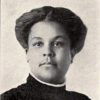

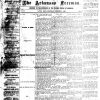


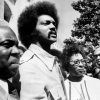



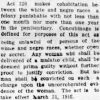


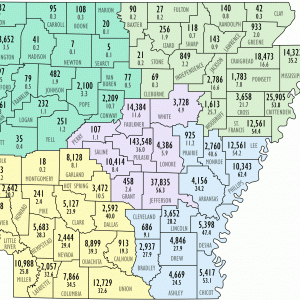



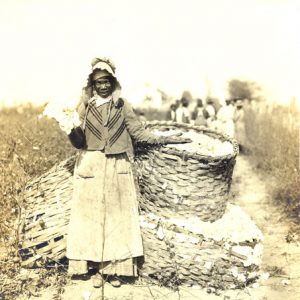
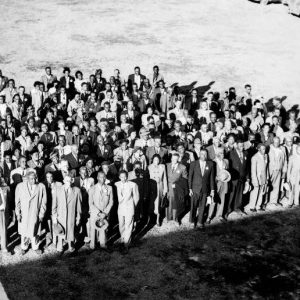

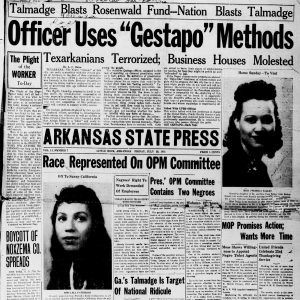
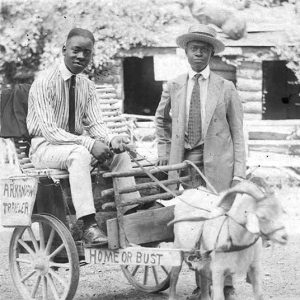


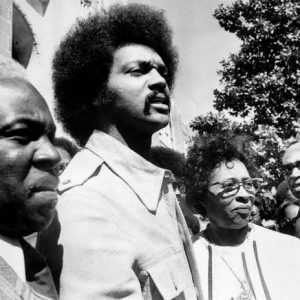

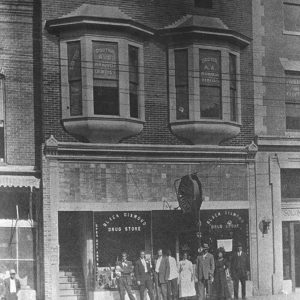
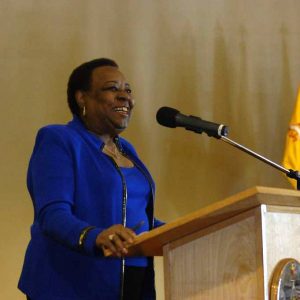
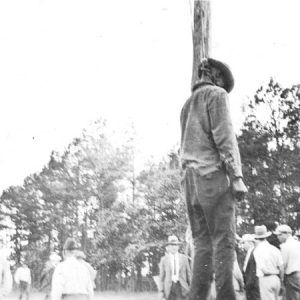
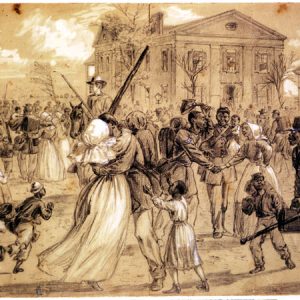
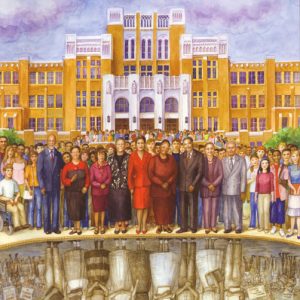
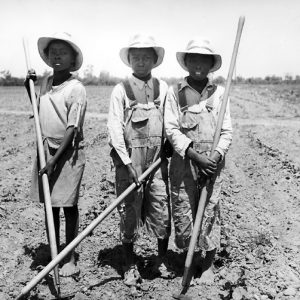
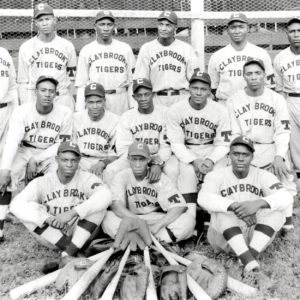


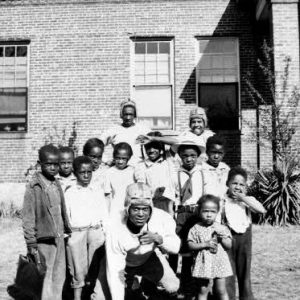
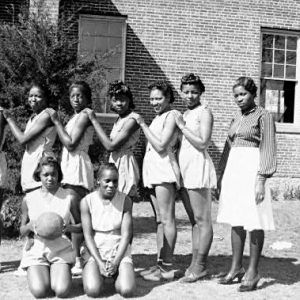
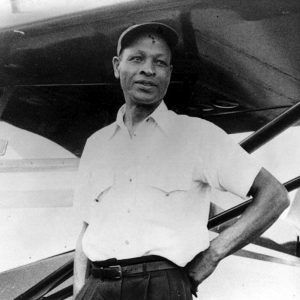

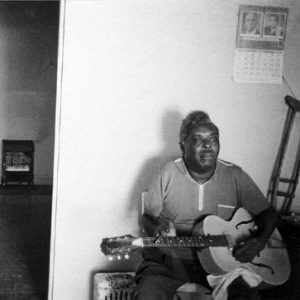
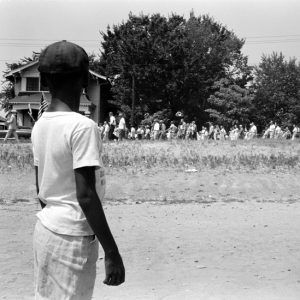
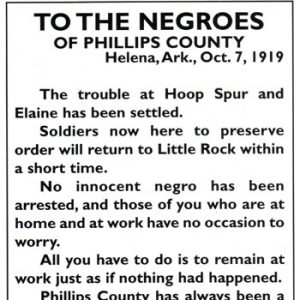
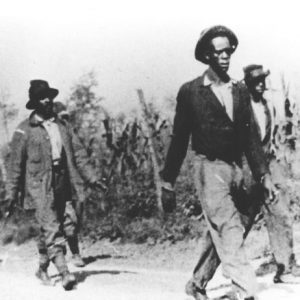

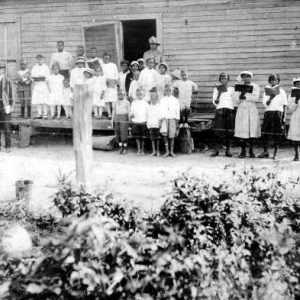
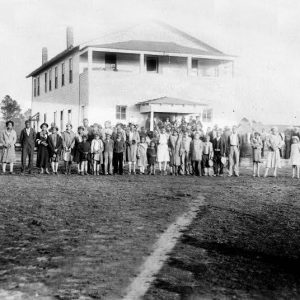
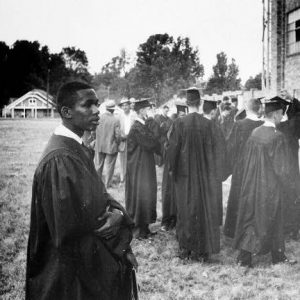

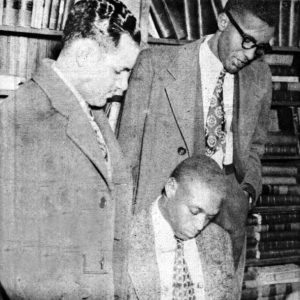

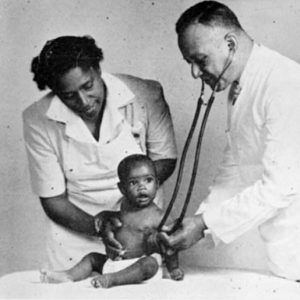
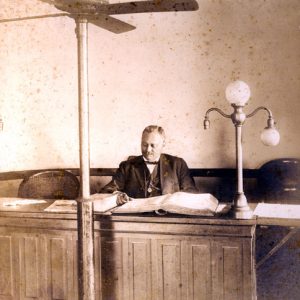
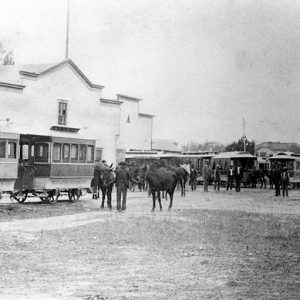
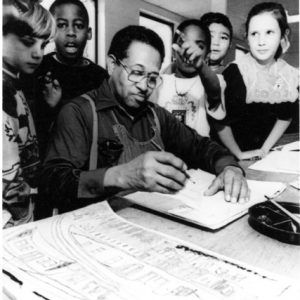
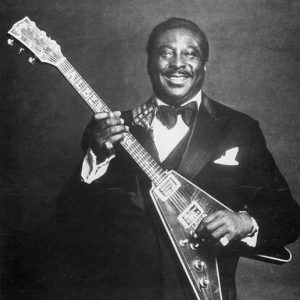
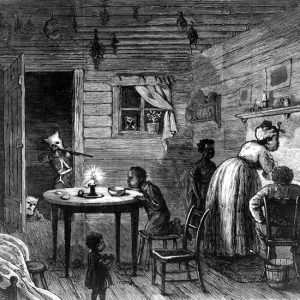
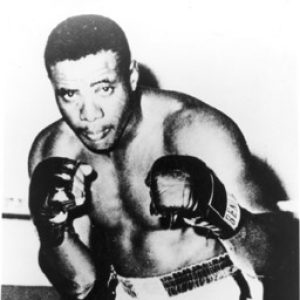
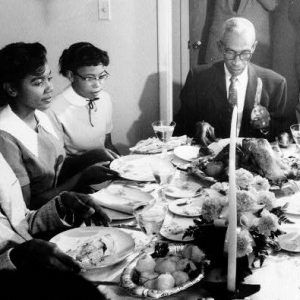

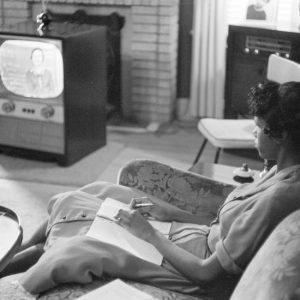

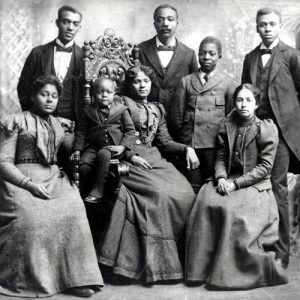

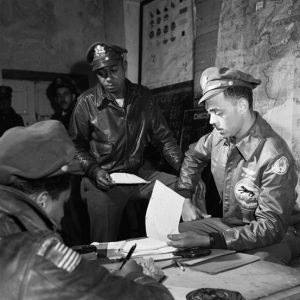



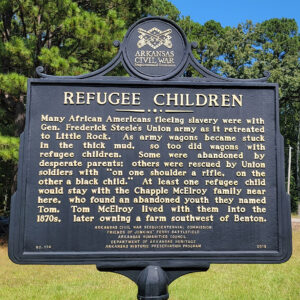



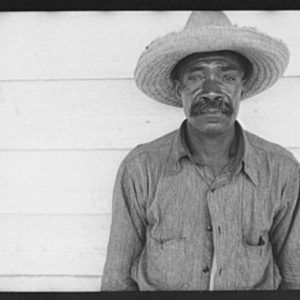
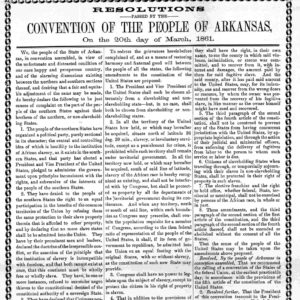
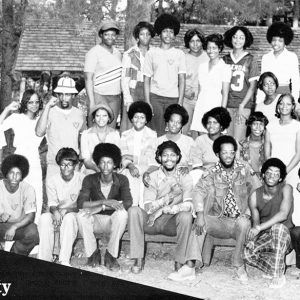
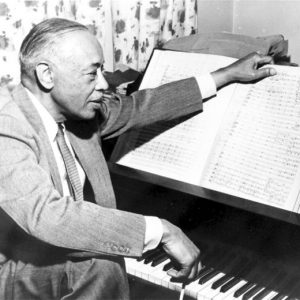
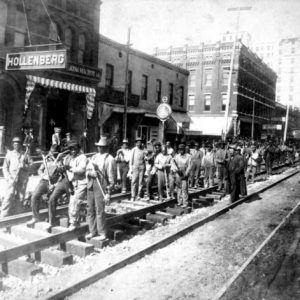
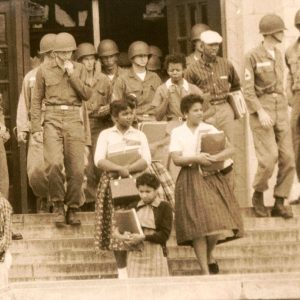

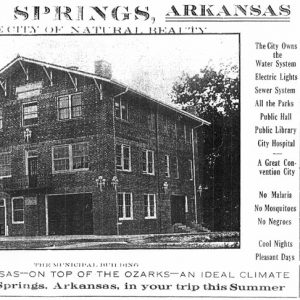
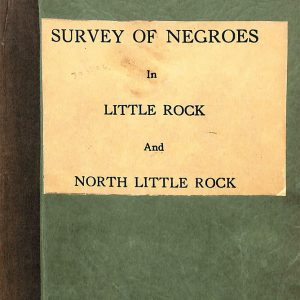
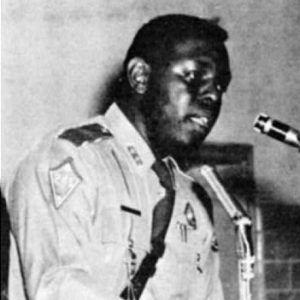
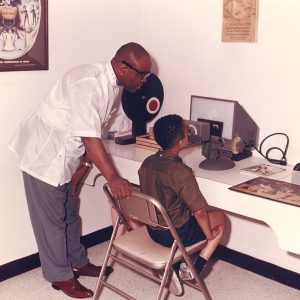
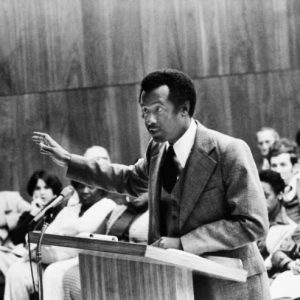
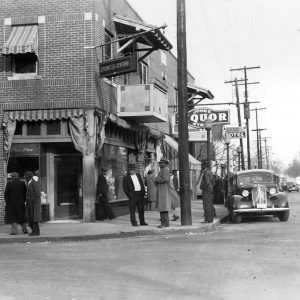



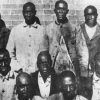
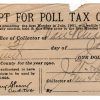




Comments
No comments on this entry yet.